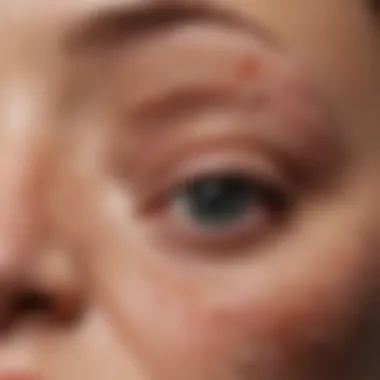Understanding Sarcoid Skin Lesions: A Comprehensive Review


Intro
Sarcoid skin lesions are a significant manifestation of sarcoidosis, a systemic disease characterized by the presence of noncaseating granulomas. These lesions can present unique clinical challenges for healthcare professionals. Understanding the key concepts related to sarcoid skin lesions is essential for accurate diagnosis and effective management.
Key Concepts and Terminology
Definition of Key Terms
Sarcoidosis: A multisystem granulomatous disease of unknown origin, commonly affecting the lungs, lymph nodes, skin, and eyes.
Skin Lesions: Abnormal changes in the skin's texture or color, often indicative of underlying systemic conditions.
Granuloma: A small area of inflammation caused by the accumulation of macrophages, lymphocytes, and other immune cells.
Concepts Explored in the Article
This article will discuss the clinical presentation of sarcoid skin lesions, common histopathological characteristics, and the challenges in diagnosis. Additionally, it will highlight risk factors that may contribute to the development of these lesions, along with an overview of potential treatments.
Findings and Discussion
Main Findings
Sarcoid skin lesions can vary widely in appearance. They might manifest as non-itchy patches, plaques, or nodules and typically appear on the face, arms, and legs. Histologically, these lesions show a predominance of epithelioid granulomas. Accurate diagnosis often requires a combination of clinical evaluation, skin biopsy, and ruling out other conditions.
Potential Areas for Future Research
Areas that may benefit from further exploration include the exact mechanisms driving the formation of granulomas in sarcoidosis. Additionally, research could delve into the impact of genetic predispositions and environmental factors on skin lesion development in sarcoidosis patients.
In summary, a thorough comprehension of sarcoid skin lesions facilitates better patient outcomes. This article aims to bridge clinical perspectives and scientific explorations, paving the way for improved diagnostic methods and treatment protocols.
Intro to Sarcoidosis
In this article, we examine sarcoidosis, a complex inflammatory disease with diverse manifestations. Understanding sarcoidosis is crucial, as it significantly affects various body systems, including the skin. Highlights of this section are key terms, clinical implications, and the relevance of skin lesions in the broader context of the disease.
Definition and Overview
Sarcoidosis is defined as a systemic granulomatous disorder. It involves the formation of granulomas, which are small clusters of immune cells, in multiple organs. Although the precise etiology remains elusive, it is believed to have an autoimmune component, with environmental and genetic factors contributing to its development. The disease can be asymptomatic or lead to significant morbidity, making awareness among healthcare professionals essential.
This condition primarily affects young adults and is more prevalent in certain populations. Prompt diagnosis is essential, as early intervention can improve outcomes. Skin involvement can occur in up to 30% of patients, with lesions serving not only as a marker of the disease but also as a source of discomfort and psychosocial distress.
Epidemiology of Sarcoidosis
Epidemiological studies reveal various trends regarding sarcoidosis. The incidence varies widely across geographic regions and racial groups. In the United States, it is more common among African Americans compared to Caucasians and Asian populations. Some studies suggested a higher prevalence in Northern European countries as well.
Key factors influencing the epidemiology of this disease include:
- Age: Most cases are diagnosed in individuals aged 20 to 40 years.
- Sex: Women show a slightly higher incidence than men.
- Ethnicity: African American individuals have a higher risk of developing sarcoidosis.
Most importantly, the epidemiology of sarcoidosis highlights the need for targeted research and community awareness. Understanding the demographic factors can aid in developing strategic public health initiatives.
Skin Manifestations in Sarcoidosis
Skin manifestations of sarcoidosis are pivotal when examining the overall impact of this complex disease. The skin serves as a barometer for underlying systemic processes, making the study of sarcoid skin lesions crucial for clinicians and researchers alike. Interpreting these manifestations can provide insights into the severity of the disease and its potential complications. Moreover, understanding cutaneous signs is essential for timely diagnosis and effective management strategies.
Characteristics of Sarcoid Skin Lesions
Sarcoid skin lesions typically possess specific characteristics that set them apart from other dermatological conditions. These lesions often present as asymptomatic or mildly symptomatic and can vary significantly in appearance and distribution. They are usually associated with the formation of non-caseating granulomas, a hallmark of sarcoidosis. This granulomatous inflammation can lead to various skin changes, often influencing prognosis and treatment decisions.
Some general features include:
- Color: Lesions may appear as red, brown, or purplish patches, depending on the skin type and lesion age.
- Size: Skin lesions vary from small papules to larger plaques or nodules, indicating the degree of disease involvement.
- Texture: The texture of these lesions can be smooth or bumpy, again reflecting the underlying pathology.


Together, these characteristics help differentiate sarcoid lesions from other skin conditions, underscoring their clinical importance.
Common Types of Skin Lesions
Plaques
Plaques are among the most frequently observed types of sarcoid skin lesions. They typically appear as raised, flat areas of skin that can be red or brown in color. The significant aspect of plaques in sarcoidosis lies in their visibility and easy identification. This well-defined characteristic helps healthcare professionals in diagnosing sarcoidosis when presented alongside systemic symptoms.
The unique feature of plaques is their potential to cover larger areas of the skin, leading to possible cosmetic concerns for patients. While treatment options are available, the persistent nature of these plaques can pose challenges in achieving aesthetic improvement.
Nodules
Nodules represent another common type of sarcoid skin lesion, often presenting as firm, raised bumps beneath the skin surface. Their key characteristic includes being well-circumscribed and movable upon palpation. This feature aids in distinguishing them from other dermatological conditions, such as cysts or lipomas.
Nodules can be both beneficial in prompting further investigation of sarcoidosis and challenging in terms of management. They may resolve on their own but can also require corticosteroid injections or other treatments. The context of their occurrence and persistence demands careful clinical evaluation.
Scar-like Lesions
Scar-like lesions occur as a result of previous active inflammation and often leave behind areas of altered skin. Their main characteristic includes a more fibrous and less elastic texture compared to surrounding skin. This transition may indicate chronic sarcoidosis that has undergone some level of healing.
Scar-like lesions can be troubling for patients due to their permanent nature. Unlike the other types of lesions, these scars may not respond well to treatment, which can affect patient satisfaction and psychological well-being. Generally, their presence serves as a reminder of past disease activity, underlining the importance of ongoing skin and systemic evaluation in sarcoidosis management.
In summary, understanding the characteristics and types of sarcoid skin lesions provides valuable insight into the disease process and aids in the broader management of sarcoidosis.
Histopathology of Sarcoid Skin Lesions
Microscopic Features
Microscopic analysis of sarcoid skin lesions reveals distinctive characteristics. Histologically, these lesions are marked by non-caseating granulomas, a hallmark of sarcoidosis. Granulomas consist of aggregated macrophages that transform into epithelioid cells, multinucleated giant cells, and lymphocytes. They form in response to an unknown antigen, which triggers an immune response.
Key features include:
- Non-caseating granulomas: Unlike other granulomatous diseases, sarcoid lesions do not exhibit caseation.
- Lymphocytic infiltration: Often found surrounding the granulomas, indicating an active immune response.
- Epithelioid cell formation: These specialized macrophages exhibit an important role in granuloma formation.
These features form the basis for the histopathological diagnosis of sarcoid skin lesions, guiding clinicians in their approach to treatment and management.
Granuloma Formation
Granuloma formation is central to the pathological process of sarcoidosis. The precise mechanisms behind this process are still not fully understood. However, it is believed that the formation results from a dysregulated immune response to a presumed environmental or infectious agent.
Steps involved in granuloma formation include:
- Antigen recognition: Antigens trigger a response from macrophages.
- Macrophage activation: This leads to the transformation of macrophages into epithelioid cells, enabling them to aggregate.
- Formation of multinucleated giant cells: These cells result from the fusion of macrophages, contributing to the granulomatous structure.
- Chronic inflammation: The continued presence of the antigen and activated immune cells sustains the inflammatory response.
The presence of granulomas influences the clinical course of sarcoidosis. They can cause tissue damage, leading to complications in affected organs. Understanding the granulomatous response provides insight into potential therapeutic strategies.
Histopathological evaluation is not only vital for diagnosis but also offers clues about disease progression and potential complications.
In summary, the histopathology of sarcoid skin lesions provides crucial information for clinicians and researchers. Understanding the microscopic features and the process of granuloma formation enhances the management of this complex condition. Accurate diagnosis based on these histopathological insights can lead to more effective treatment strategies for those affected.
Diagnosis of Sarcoid Skin Lesions
Diagnosis of sarcoid skin lesions is essential for determining the appropriate clinical management and treatment strategies. The complex nature of sarcoidosis, which presents a variety of skin manifestations, requires careful assessment and diagnosis. Timely and accurate diagnosis can significantly impact treatment approaches and patient outcomes. In this section, we will delve into various methods and approaches employed in the diagnosis of sarcoid skin lesions.
Clinical Evaluation
Clinical evaluation is often the first step in diagnosing sarcoid skin lesions. A thorough history and physical examination are crucial for assessing the nature and progression of skin manifestations. Physicians look for specific characteristics of the lesions, such as their size, shape, color, and distribution. Additionally, any associated symptoms, such as itching or pain, may be noted.
Dermatologists typically take note of a patient’s medical history, including any prior diagnosis of sarcoidosis or related conditions. This context is invaluable as it helps to ascertain the likelihood of sarcoidosis as the underlying cause. Furthermore, a focused examination of other body systems may reveal systemic involvement, which is often present in sarcoidosis.
Diagnostic Tests


Skin Biopsy
Skin biopsy is a fundamental diagnostic tool in evaluating sarcoid skin lesions. This procedure involves the excision or sampling of the lesion for histopathological analysis, allowing for a detailed examination of tissue characteristics. A skin biopsy is considered essential as it can reveal the presence of non-caseating granulomas, which are hallmark findings in sarcoidosis.
The key characteristic of skin biopsy is its ability to provide a definitive diagnosis. Unlike other methods, which may only indicate the possibility of sarcoidosis, a biopsy directly visualizes the pathological changes within the skin. This makes it a popular choice in both clinical practice and research settings.
However, one disadvantage of skin biopsy includes the risk of local complications, such as infection or scarring, which can be a concern for patients. Additionally, in some cases, granulomas may not be present in the sampled area, potentially leading to false-negative results.
Imaging Studies
Imaging studies, such as chest X-rays and CT scans, play a critical role in the diagnosis of sarcoidosis when skin lesions are present. While imaging alone cannot confirm sarcoidosis, it helps in assessing the extent of any internal organ involvement.
One of the key characteristics of imaging studies is their ability to visualize granulomatous changes in the lungs or lymph nodes, which are common in sarcoidosis. This offers valuable insights into determining the systemic impact of the disease.
The unique feature of imaging studies is their non-invasive nature. They provide immediate results and can help in monitoring the disease's progression. However, these methods may not be specific to sarcoidosis and can yield misinterpreted findings associated with other conditions.
Serological Tests
Serological tests measure specific biomarkers in the blood that may indicate the presence of sarcoidosis. Although these tests are not always diagnostic for sarcoid skin lesions alone, they can help in building a comprehensive understanding of the disease.
A key characteristic of serological tests is that they can identify elevated levels of certain enzymes, such as angiotensin-converting enzyme (ACE), which are often found in patients with sarcoidosis.
While serological tests can support a diagnosis when used in conjunction with other methods, they are limited by low specificity. Elevated ACE levels may not be present in all sarcoidosis patients, and can be influenced by various other conditions.
Differential Diagnosis
Differential diagnosis is crucial when evaluating sarcoid skin lesions. Numerous skin conditions can mimic sarcoidosis, making it essential for clinicians to consider alternative diagnoses. The evaluation process should involve examining similar dermatological conditions such as psoriasis, granuloma annulare, and other forms of granulomatous dermatitis.
Additionally, a comprehensive understanding of the clinical context is vital. Since sarcoidosis can exhibit systemic involvement, clinicians must consider any signs or symptoms that may suggest other diseases. Recognizing the need for thorough differential diagnosis enhances the precision of treatment and management strategies in patients with sarcoidosis.
Management of Sarcoid Skin Lesions
The management of sarcoid skin lesions is essential not only for cosmetic reasons but also for the overall well-being of affected individuals. Effective management strategies can help alleviate symptoms, prevent complications, and enhance the quality of life for patients. Addressing symptom control and treatment options is crucial in minimizing the impact of these lesions.
Physicians must tailor management approaches to suit individual patient needs. This often requires a combination of medication and monitoring to ensure optimal outcomes. Understanding the nuances of both medical treatments and follow-up care is vital for anyone involved in managing sarcoid skin lesions.
Treatment Modalities
Corticosteroids
Corticosteroids are among the most commonly used treatments for sarcoid skin lesions due to their anti-inflammatory properties. These medications work by reducing inflammation and suppressing the immune system, which helps in managing the skin lesions effectively. When considering corticosteroids, their potency and flexibility in administration provide significant advantages. They can be administered topically, injected directly into the lesion, or taken orally depending on the severity and spread of the lesions.
A unique characteristic of corticosteroids is their rapid action. Patients often notice improvements soon after starting the treatment, making this approach popular. However, users of corticosteroids must be cautious, as prolonged use can lead to skin thinning, systemic effects, and other complications. Thus, monitoring is essential during treatment.
Immunosuppressive Agents
Immunosuppressive agents are another option for managing sarcoid skin lesions, particularly in cases where corticosteroids are ineffective or contraindicated. These agents work by dampening the overall immune response, which can help control the inflammatory process.
One key feature of immunosuppressive agents is their ability to provide a long-term management solution. Medications such as Methotrexate and Azathioprine have shown efficacy in numerous cases. Despite their benefits, immunosuppressive agents are not without risks. They can increase the risk of infections, making careful patient selection and monitoring essential to avoid adverse effects.
Topical Treatments
Topical treatments offer a less invasive option for managing sarcoid skin lesions. These include various creams and ointments designed to address inflammation and promote skin healing. The main advantage of topical treatments is their localized application, which minimizes systemic exposure and potential side effects.
Topical treatments are often well-tolerated and can be used in conjunction with other therapies, adding another layer of management. However, they may not be sufficient for more severe cases where systemic treatment is necessary. The effectiveness of topical treatments can also vary depending on the individual, thus necessitating an ongoing evaluation of treatment response.
Monitoring and Follow-Up
Monitoring and follow-up are critical components of managing sarcoid skin lesions. Regular assessments allow healthcare providers to evaluate the effectiveness of treatments and make necessary adjustments. Follow-ups should include clinical evaluations along with any relevant laboratory tests to ensure proper management. The necessity of a personalized approach cannot be overstated, as each patient's experience with sarcoidosis and its skin manifestations can differ significantly.
Prognosis of Sarcoid Skin Lesions


The prognosis of sarcoid skin lesions is a significant aspect in the management of patients with sarcoidosis. Understanding prognosis helps guide treatment decisions and informs patients about their condition's potential outcomes. Sarcoidosis can affect various organs, and skin manifestations often serve as indicators of disease severity and duration. Since the cutaneous form of sarcoidosis may alter with time, a clear assessment of prognosis is essential for both medical professionals and patients alike.
Several factors influence the prognosis of sarcoid skin lesions. These elements include the type and distribution of lesions, response to treatments, and presence of associated systemic involvement. Moreover, understanding individual patient characteristics, such as age and overall health, also plays a crucial role in shaping prognosis.
Factors Influencing Prognosis
Understanding the factors influencing prognosis assists healthcare providers in predicting outcomes for those diagnosed with sarcoid skin lesions. Key factors include:
- Type of Skin Lesion: Certain lesions, such as plaques and nodules, may indicate different levels of disease severity. Lesions that are resistant to treatment often signal a more complicated prognosis.
- Systemic Involvement: When sarcoidosis affects other organs, like the lungs or heart, the overall prognosis worsens. Patients with more systemic forms of sarcoidosis typically experience a lower quality of life.
- Treatment Response: How quickly and effectively a patient responds to available treatments can significantly affect prognosis. Those who do not respond well may have a more challenging long-term outlook.
- Duration of Disease: Early diagnosis and intervention often lead to better outcomes. Patients with long-standing lesions might face persistent challenges and complications.
Evaluating these factors in conjunction with regular monitoring can help physicians create an appropriate management plan, allowing for timely interventions.
Impact on Quality of Life
The impact of sarcoid skin lesions on an individual’s quality of life cannot be overstated. Skin manifestations often lead to not only physical discomfort but also psychological distress. Patients may experience:
- Physical Symptoms: Itching, pain, and cosmetic concerns contribute to discomfort and may hinder daily activities.
- Psychological Effects: The visibility of skin lesions can lead to feelings of self-consciousness and anxiety. This can affect social interactions and mental well-being.
- Social Implications: Some patients may withdraw from social situations due to the appearance of their skin lesions, leading to social isolation.
- Economic Burden: The need for ongoing treatment and potential lost productivity can have significant financial implications.
Healthcare providers must recognize the multifaceted impact of sarcoid skin lesions on quality of life. Through comprehensive care, including addressing both physical and emotional needs, professionals can help improve patient outcomes.
Understanding the prognosis of sarcoid skin lesions is not only crucial for predicting disease progression, but also for significantly enhancing the overall well-being of patients.
Research and Advancements
Research into sarcoid skin lesions is critical for numerous reasons. As the understanding of this condition evolves, advancements in diagnostic and treatment modalities can directly influence patient outcomes. The intricate relationship between sarcoidosis and its dermatological manifestations underscores the need for ongoing exploration in this field. This section examines current trends and potential future directions in sarcoidosis research, shedding light on the implications for clinical practice.
Current Research Trends
Recent trends in sarcoidosis research emphasize the importance of identifying the underlying mechanisms that contribute to the formation of skin lesions. Investigators are focusing on the pathophysiology of granuloma formation, which is central to understanding sarcoidosis as a whole. The role of immune responses is being studied in-depth, including how various cytokines and chemokines interact during the inflammatory process.
Additionally, there's increasing interest in the genetic factors that might predispose individuals to develop sarcoidosis and associated skin lesions. Many studies are exploring polymorphisms in genes that regulate immune function, thus potentially identifying targets for therapeutic intervention.
Recent clinical trials are also investigating the efficacy of novel treatments beyond traditional corticosteroids. These include immunomodulators that might better manage symptoms with fewer side effects, particularly in severe or refractory cases.
Moreover, the advent of advanced imaging techniques is enabling researchers to improve diagnostic accuracy. Imaging not only aids in visualizing skin lesions but also helps clinicians evaluate systemic involvement more effectively.
Future Directions in Sarcoidosis Research
Looking ahead, the future of sarcoidosis research appears promising yet complex. There is a growing recognition of the need for multidisciplinary approaches that integrate dermatology, pulmonology, and immunology. Understanding how sarcoidosis affects various organ systems can yield insights into the interconnectedness of symptoms.
Moreover, addressing health disparities in sarcoidosis research is crucial. Specific populations are disproportionately affected by sarcoidosis, often with differing clinical courses. Research efforts should focus on equity, ensuring that findings are applicable across diverse demographics.
The exploration of biomarkers in sarcoidosis is another promising avenue. Identifying specific biomarkers could lead to earlier diagnosis and personalized treatment strategies, enabling tailored therapies based on individual patient profiles.
In terms of therapeutic innovations, ongoing research will likely continue exploring engineered biologics or targeted therapies that modulate specific pathways involved in immune response. The ultimate goal is to enhance patient care in a meaningful way through effective management of both skin lesions and systemic disease.
"Advancements in research can significantly change the clinical landscape of sarcoidosis, improving both diagnosis and treatment outcomes for patients."
As this field evolves, collaboration among researchers, healthcare providers, and patients will be essential to drive innovative solutions and enhance understanding of this multifaceted condition.
Epilogue
Summary of Insights
In summary, the readers have explored a wide array of information related to sarcoid skin lesions. This includes their clinical features, the microscopic characteristics noted in histopathology, and the complexities involved in diagnosis and management. Key points discussed include:
- The distinct nature of sarcoid skin lesions, including plaques, nodules, and scar-like formations.
- The diagnostic approach which integrates clinical evaluation with a selection of diagnostic tests, including skin biopsy and imaging studies.
- Management strategies that range from corticosteroid use to more targeted immunosuppressive therapies.
The combination of clinical findings and research advancements serves to provide a holistic understanding of the implications of these skin manifestations in the context of an overall systemic disease.
"Sarcodosis can present in many forms, each warranting a specific diagnostic and treatment approach."
Call for Further Study
Future research on sarcoid skin lesions is crucial. There is a need for deeper exploration into the underlying mechanisms driving the formation of lesions. Areas worth investigating include:
- The genetic and environmental factors that contribute to disease onset.
- Long-term outcomes of different treatment methods on quality of life for affected individuals.
- Development of new therapies that could potentially offer better management of skin lesions.







